
Chapter 3. What We Know About Large Trees That Fall Into Streams and Rivers
James R. Sedell, Peter A. Bisson, Frederick J. Swanson,
and Stanley V. Gregory
Summary
The most productive habitats for salmonid fish are small streams associated with mature and old-growth coniferous forests where large organic debris and fallen trees greatly influence the physical and biological characteristics of such streams.
Introduction
In western Oregon, most of the 17,000 miles of fish-bearing waterways are small streams averaging less than 10 feet wide; shown below is the mileage by ownership:

Dense vegetative canopies help keep waters cool, and falling tree litter delivers nutrients to the stream portion of the ecosystem. Large organic debris and fallen trees greatly influence the physical and biological characteristics of small streams that may contain as much as 200-700 tons/acre of such material (Anderson and others 1978, Bisson and others 1987, Franklin and others 1981, Harmon and others 1986, Keller and Swanson 1979, Swanson and Lienkaemper 1978).
History of Wood in Northwest Streams and Rivers
Most early descriptions of streams and rivers in the Northwest were recorded in British and United States army journals. Valleys were so wet that early travel was confined to edges of the hills (Dicken and Dicken 1979). Oregonís Tualatin Valley was "mostly water connected by swamps" (Ogden 1961, p. 122). Much of this flooding resulted from beaver dams, accumulated sediment, fallen trees, and living vegetation in the channels. The valley bottoms had long accumulated alluvial silt and organic material, so the land was drained for agriculture early in the time of settlement.
Page 47
The condition of Willamette Valley streams in 1910 was described by Williams (1914, p. 13):
Many of the smaller streams...through these flat sections of the valley flow sluggishly and frequently overflow their banks during periods of heavy winter rainfall.... Most of these have sufficient grade to carry even more water than ordinarily comes to them; seldom less than 3, and usually more, feet of fall per mile. The annual overflow is caused from the obstructing of the channel by the growth of trees and the extension of their roots, the dams thrown across the channels by beavers and the consequent accumulation of sediment and other debris.... It is common condition, however, and usually all that is necessary is a clearing out and opening up of the clogged channel of the stream to afford entire relief...to the farmer....
Streams of the Puget Sound lowland in Washington State were also a network of sloughs, islands, beaver ponds, and driftwood dams with no main channel. The Skagit River lowlands encompass about 198 square miles, of which more than 50 square miles were once marsh, sloughs, and wet grass meadows. Maps of the lower Nooksack and Snohomish Rivers show large areas of sloughs, swamps, and grass marshes before 1900 (Reports of the Secretary of War 18751921).
The channels of both high- and low-gradient rivers contained large amounts of woody debris, regardless of the bed material. The lower Siuslaw River and North Fork Siuslaw River were so filled with fallen trees that trappers could not explore much of these systems in 1826 (Ogden 1961).
In 1870, the Willamette River flowed in five separate channels between Eugene and Corvallis. Reports of the Secretary of War (18751921) describe many obstacles to navigation of the Willamette River above Corvallis and say that the riverbanks were heavily timbered for half a mile on either side. More than 5,500 drifted, dead trees were pulled from a 50-mile stretch of river in a lo-year period. These trees ranged from 5 to 9 feet in diameter and from 90 to 120 feet in length. The river was also confined to one channel by engineering activities.
Many other rivers in Oregon and Washington were completely blocked by driftwood in the lower, main channels; the Skagit River had a driftwood jam three-fourths of a mile long and one-fourth of a mile wide. The Stillaguamish River was closed by six driftwood jams from the head of tidewater to river mile 17. Drifted, dead trees were so numerous, so large, and so deeply imbedded in the bottom that a steam "snag boat" operated for 6 months to open a channel only 100 feet wide.
Page 48
Driftwood in high-gradient river systems often jams where the channel gradient is abruptly decreased. A section of the South Fork Nooksack River was described by Morse (1883, p. 9):
...we came to a place where the river, during freshets had ground sluiced all the earth away from the roots of the trees, and down some 6 feet to the gravel. This covered a region of country a mile in width by five in length. Overgrown yellow fir timber had once covered most of that section. If the river below there was only clear of jams that place would be paradise of hand loggers. On the gravel lay many million feet of sound fir timber, which only needed to be junked up during the summer and the winter freshets would float the logs down to the sea. Immediately below this place, the jams first extend clear across the river, and for the next 20 miles there is a jam across the river nearly every mile.
Large, woody debris was obviously an important part of early river systems of the Pacific Northwest; however, human objectives dictated that debris be cleared from river channels. Throughout North America, people have systematically cleaned downed trees and woody debris from streams for more than 150 years (Sedell and Luchessa 1982, Sedell and others 1982b). From the mid-1800ís to about 1920, large and intermediate-size rivers in North America were cleaned so steamboats and rafts could navigate. From the 1880ís to about 1915, small rivers and streams were cleaned so logs could be transported from the woods to the mills (fig. 3.1). Splash dams were built on many streams to temporarily augment the flow so logs could be floated (Sedell and Duval 1985, Sedell and Luchessa 1982) (fig. 3.2). Such channel clearance and splash damming removed large quantities of woody debris from medium to large streams, which significantly changed the physical and biological conditions of the streams (Harmon and others 1986).
During the 1950ís and 1960's, west coast fishery managers feared that woody debris in streams restricted fish passage, supplied material for log jams, and caused channel scouring during floods (Hall and Baker 1982, Narver 1971). The great ecological value of organic debris was not yet known, and during times of extreme water-flow, all the managersí fears might be realized (Gharrett and Hodges 1950, McKernan and others 1950). The result of these fears was that fishery biologists were forced into the role of river engineers, a part for which they were not trained.
Debris is not now removed on the same scale as in the 1950ís and 1960's, but removal is still a large part of salmon enhancement programs in several Western States and is mandated by virtually every State Forest Practices Act in the western United States and Canada. The combination of removal of debris in watershed headwaters so that fish could pass, splash damming, and removal of drifting wood and log jams from large rivers has left entire drainage systems almost devoid of largewood (Sedell and Swanson 1984).
Page 49

Figure 3.1-Logs in a small stream awaiting enough water to be floated to the mill (photo from USDA Forest Service historical files).

Figure 3.2-A splash dam at Austin Place, Hamilton Creek, Oregon, August 16, 1907. Such dams were used to regulate the flow of water to float logs down a stream to the mill (historical photo, courtesy of the Horner Museum, Oregon State University).
Page 50

Figure 3.3-Stream order (after Strahler 1957) in a typical watershed. The majority of stream mileage is in first- and second-order tributaries in all watersheds of western Oregon and Washington.
Stream Categorization
Streams are characterized by their "order" (Strahler 1957) (fig. 3.3). Headwater stream channels are designated first-order; two first-order streams combine to form a second-order stream. Two second-order streams combine to form a third-order, and so forth.
In western Oregon, first- and second-order streams constitute 79 percent of the total stream mileage (Boehne and House 1983) (table 3.1). Such streams rise in very small watersheds with limited water storage capacity. These streams may have only scanty or intermittent flow during the dry season, but during high flows they may move large amounts of sediment and woody debris. Headwater streams mainly determine the type and quality of downstream fish habitat.
First- and second-order streams are influenced by the geomorphology, soils, and vegetation of their channels. Large woody debris is common, covering as much as 50 percent of the channel (Anderson and Sedell 1979, Swanson and Lienkaemper 1978, Triska and others 1982). The stream is continuously shaded by vegetation. Flow energy in the channel is continually dissipated by woody material and vegetation that slow erosion and foster deposition of organic and inorganic materials. The average gradient of these streams often exceeds 10 percent, but the channels usually have a stairstep configuration of flat reaches connected by riffles and low falls. Salmonid reproduction may be sufficient, even in some ephemeral streams, to furnish fry to larger waters downstream (Everest 1973, Everest and others 1985).
Page 51
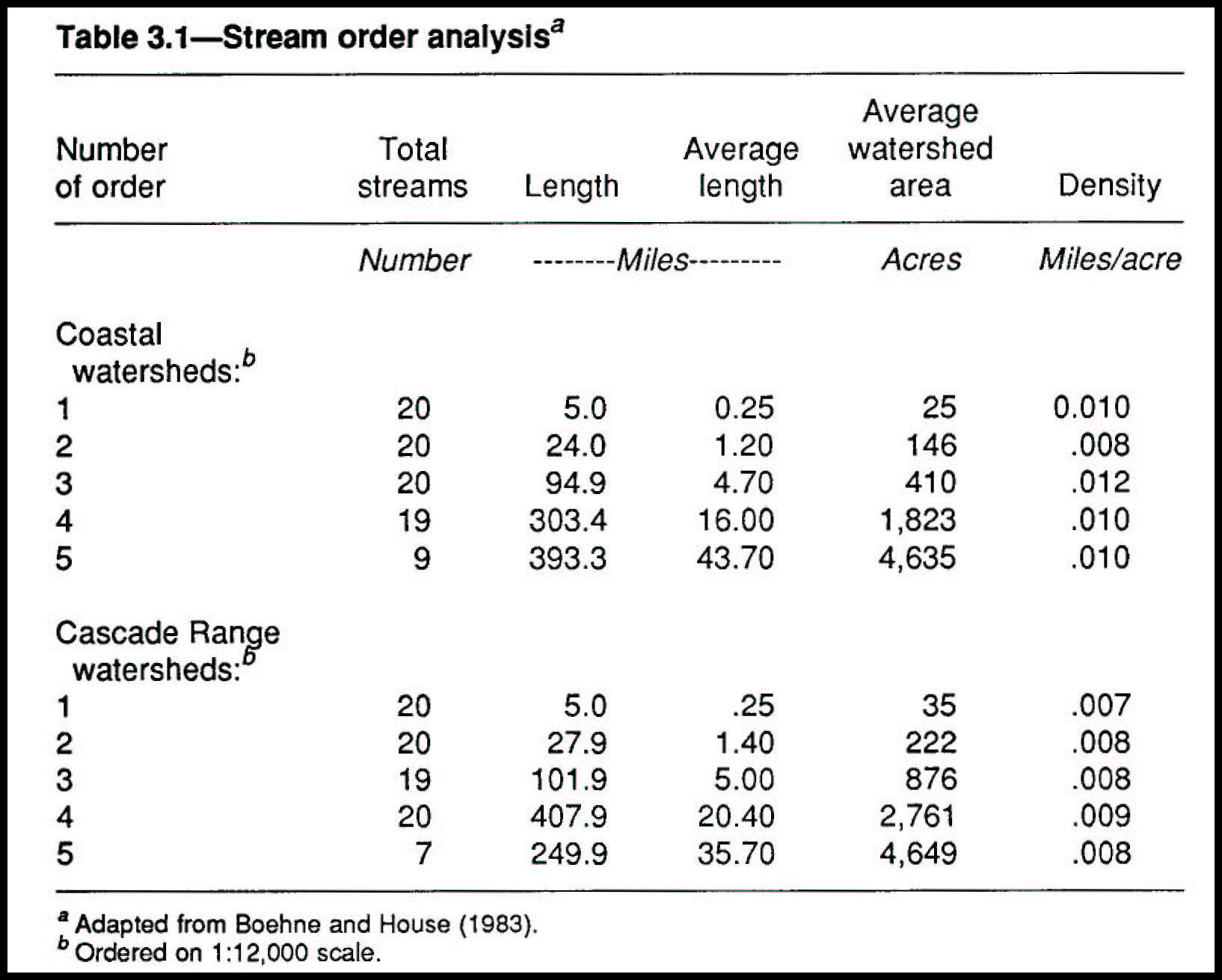
Third- and fourth-order streams usually flow continuously. Average gradient is less than 5 percent, but there may be intermittent stretches of rapids or falls. Woody debris usually covers less than 25 percent of the channel. High flows may flush woody material from the system or deposit it in jams. The vegetative canopy over third- and fourth-order streams varies in density. These streams can transport large amounts of sediments, which are often deposited around channel obstructions, in narrow, winding areas, or in other areas of low velocity-accretion bars, estuaries, and the flood plain.
The direct influence of riparian areas is moderated in fifth-order and larger streams but remains important. Canopies of large, old-growth trees provide some shade, vegetated riparian zones keep the main channel confined, and the largest stems of down trees that remain in the stream provide important summer and winter salmonid habitat. Flood plains of the larger streams contain complex arrays of side channels, overflow channels, and isolated pools. Side channels are often created and maintained by large woody debris (Bisson and others 1987, Sedell and others 1984). The gradient in large streams is usually less than 1 percent, but rapids and falls may occur. Alluvial material and woody debris may be deposited in quiet areas, but accumulations are flushed and rearranged during high flows.
Page 52
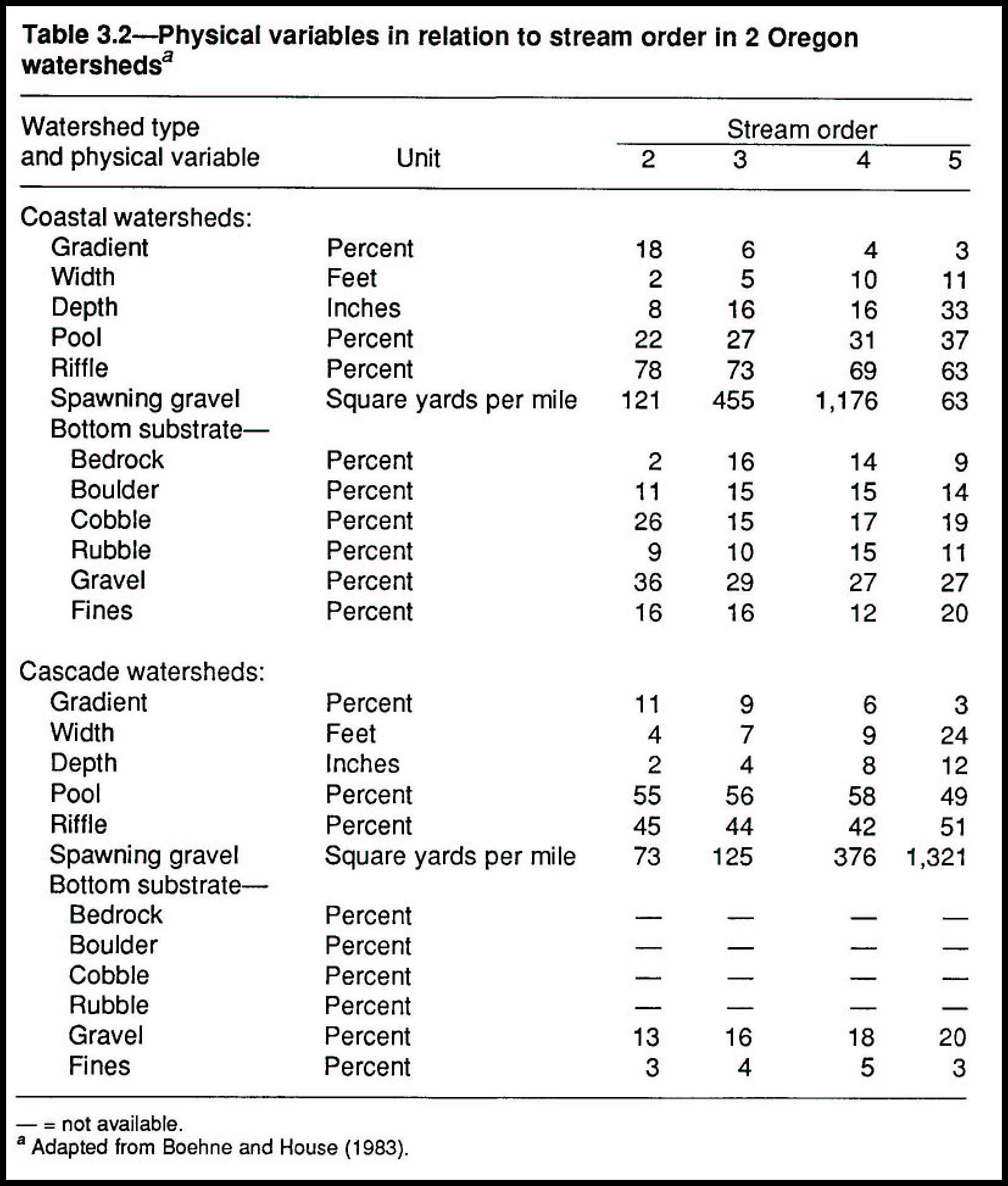
Most salmonids spawn in fourth-order coastal streams and fifth-order watersheds in the Cascade Range (table 3.2). Resident salmonids use some second-order coastal streams but are nearly always found in third-order or larger streams. Fourth- and fifth-order streams in western Oregon can support rearing of anadromous salmonids unless barriers or gradients of more than 12 percent stop upstream movement of adults.
Page 53
Ecosystem Structure and Function in Unmanaged Streams
The stream network is a spectrum of physical environments and associated biotic communities (Vannote and others 1980). Streams form a longitudinally linked system in which downstream processes (cycling of organic matter and nutrients, ecosystem metabolism, new metabolism) are linked to upstream processes. The spectrum concept is a good framework for studying and managing streams as heterogeneous systems (OíNeil and Reichle 1980). Useful generalizations can be developed about magnitude and variation of organic matter through time and space, the structure of invertebrate and fish communities, and resource partitioning along the entire river.
First- and second-order streams feed third- and fourth-order streams with partially used food, the amount of which becomes progressively smaller as stream order increases. Small streams derive much food for invertebrates from wood or leaf litter under old-growth forests. The forest influence diminishes as streams become progressively larger and the stream energy base comes more from algae and less from forest litter (fig. 3.4). The forest influence is greatest in very small streams, but most diverse organic input mechanisms and habitats are in third- to fifth-order streams. Invertebrates reflect these downstream shifts with fewer shredders (leaf eaters) and more grazers (algal feeders) in small rivers (fig. 3.4). Dominant organisms change as the size of a forested stream changes, as does the role of each functional group of organisms in using organic materials (fig. 3.4).
Page 54

Figure 3.5-Woody debris in a small pristine stream.
Consider a first-order woodland stream and a sixth-order stream (intermediate-size river) in the context of continuums of communities with associated abiotic factors (fig. 3.4). Both systems include the same organic processing components, but they vary in relative magnitude of the components, rates and amounts of organic transfer between components, and species engaged in the transfers. The two systems are essentially modifications of the same trophic scheme, so the entire stream-to-river complex can be considered a single system composed of a series of communities along a continuum.
The continuum example deals primarily with food resources for organisms ranging from invertebrates to fish. More important to resource management, however, is the ecological rationale for a protective vegetation zone along streams and rivers of all sizes. Streamside vegetation zones are justified on the grounds of stream temperature control, bank stabilization, and food resources. Streamside vegetation is also the primary supplier of large organic debris-snags or tree stems 8 inches in diameter with the rootwads attached, or tree branches more than 8 inches in diameter.
Forests adjacent to streams supply large debris (stems, rootwads, large limbs) (fig. 3.5). Erosion may contribute debris to streams and account for water transporting pieces of debris. Organic debris in streams increases aquatic habitat diversity by forming pools and protected backwater areas, provides nutrients and substrate for biological activity, dissipates energy of flowing water, and traps sediment.
Aquatic ecologists, hydrologists, and geomorphologists only recently have recognized that large organic debris has always been an important part of forested streams. For western streams, such recognition developed from the following viewpoints: manipulation by humans (Bisson and others 1987, Froehlich 1973, Heede 1972, Marzolf 19781, functions of the ecosystem (Bilby 1981, Bilby and Likens 1980, Harmon and others 1986, Meehan and others 1977, Sedell and Swanson 1984, Swanson and others 1976, Triska and others 1982), and the historical aspect (Sedell and Froggatt 1984, Sedell and Luchessa 1982, Sedell and others 1982a, Triska 1984).
Page 55
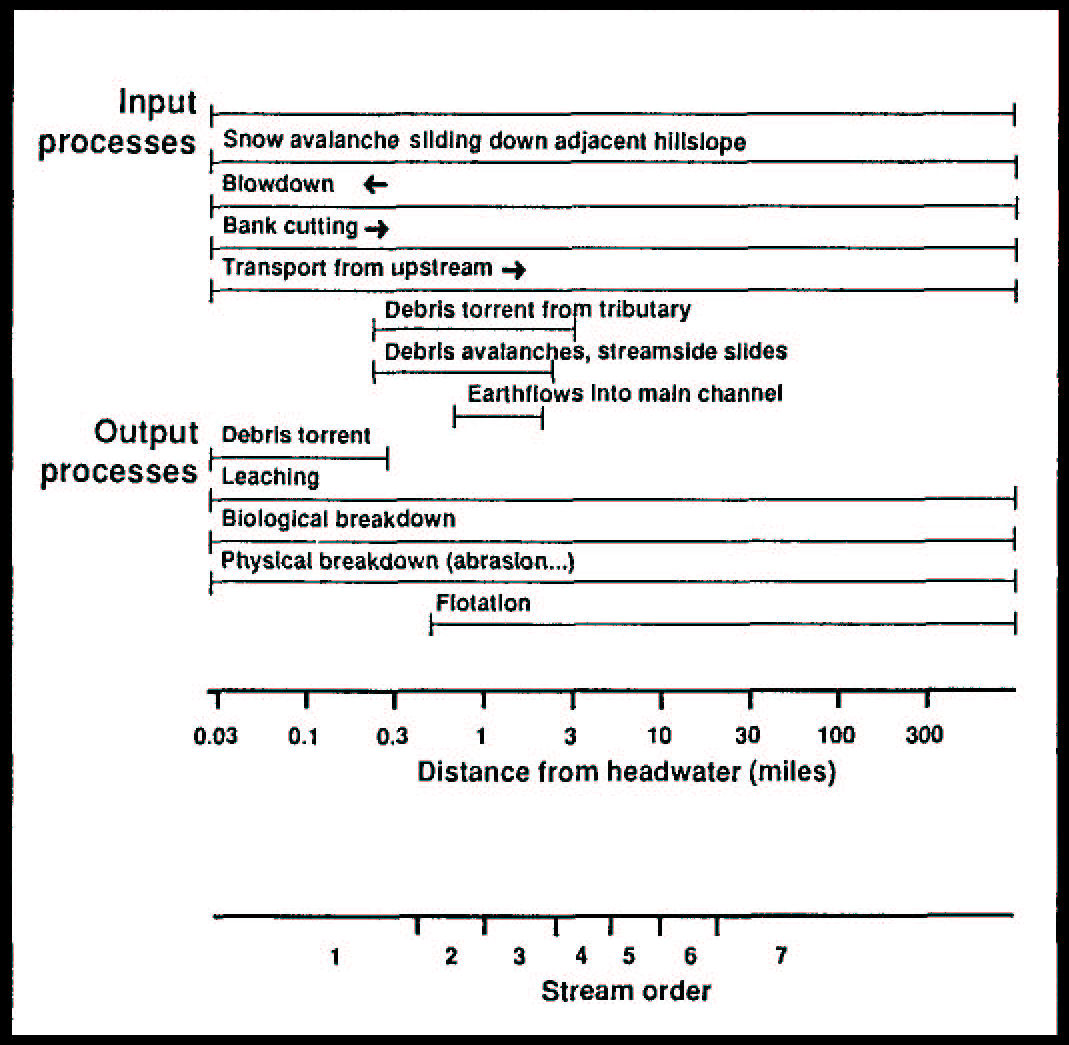
Figure 3.6-Debris input and transport processes by stream order in the McKenzie River system of western Oregon. Arrows indicate direction of increasing importance (adapted from Keller and Swanson 1979).
Several mechanisms transfer large woody debris to stream channels: bank under-cutting and collapse, tree blowdown, tree collapse from snow or ice, snow avalanches, and mass soil movements (Keller and Swanson 1979). Each of these mechanisms contributes in some way to channel, slope, forest stand processes, watershed geology, and stream size.
The processes of transferring large pieces of wood from forests to stream channels are: chronic-frequent inputs irregular in time and space; and episodic-infrequently spaced, often very large inputs (fig. 3.6). Chronic input processes include tree mortality from disease and insects combined with windthrow or gradual stream under-cutting of root systems. Episodic input processes include large-scale epidemics of insects or diseases, extensive blowdown (fig. 3.7), logging, debris avalanches, and massive erosion of banks during major floods.
Forest succession alters the composition of woody material entering streams through mortality and bank undercutting, causing trees to fall after logging. In young-growth plantations of the Pacific Northwest, low- to mid-elevation riparian zones are dominated by deciduous species, such as red alder, if no mature conifers remain along the stream after logging. Most trees that enter stream channels in young-growth sites are red alder (fig. 3.8, color), which has a shallow root system, and therefore, low resistance to undercutting. The rate of input of young-growth conifer debris is slow and does not increase until about 60 years after logging (Grette 1985) (fig. 3.9).
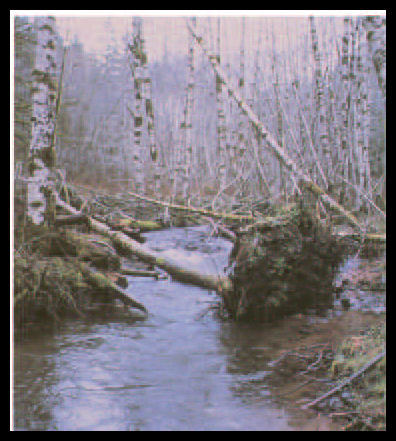
Figure 3.8-Most trees that enter stream channels in young-growth sites are red alder, which has a shallow root system and low resistance to undercutting.
Page 56
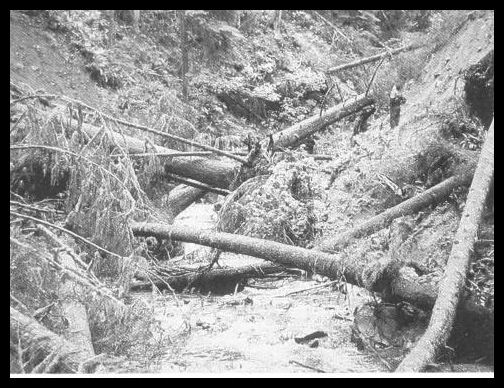
Figure 3.7-Blowdown is a major cause of large woody debris in streams.
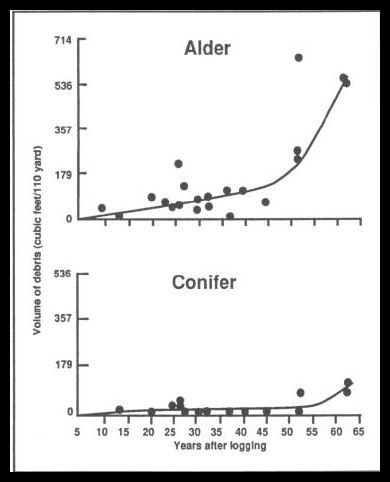
Figure 3.9-Red alder and conifer debris in small streams in second-growth forests in western Washington (adapted from Grette 1985).
Chronic inputs of woody debris larger than 20 inches in diameter are more common in mature and old-growth forests because of tree mortality than in young-growth stands where most or all of the trees are small. Inputs of smaller debris (less than 4-inch diameter) from young stands may, however, equal or exceed the rate of input of small debris from old-growth forests (Long 1987).
Page 57
Distribution of Fallen Trees
The location, stability, and longevity of debris influence the quality of habitat in all fish-bearing streams, although the arrangement of woody debris varies according to stream size and valley morphology (Swanson and others 1976). Spacing of individual pieces of debris or clumps of pieces can be strongly influenced by input processes. If the dominant input is from bank undercutting of living trees or direct falling of dead trees, debris is spaced at random intervals along very small channels where discharge is insufficient to carry the debris pieces downstream. In most fish-bearing streams, however, there is some degree of debris clumping, the magnitude and spacing of which generally increases downstream. In streams wider than 5 to 7 feet (usually third- to fourth-order), woody debris enters the stream after bank undercutting. Trees that fall directly into the stream are moved during storms and deposited on channel obstructions and on the outsides of river bends near the high water line. Deposited debris may greatly increase width of the channel, produce midchannel bars, and facilitate the formation of meander cutoffs (Keller and Swanson 1979). Short, braided stream reaches and secondary channel systems formed in this manner are especially productive sites for rearing salmon and trout in Pacific Northwest rivers (Sedell and others 1984).
A major flood moves live trees to the stream, but downed trees and stumps can enter or leave streams annually with smaller floods. Large streams that flow through steep, narrow valley walls (for example, ravines) often cannot develop deposition zones, so they become dominated by boulders rather than by large woody debris.
Clumps caused by debris avalanches, extensive blowdown, or movement of large amounts of material from the flood plain in a major flood tend to be more widely spaced and of greater volume than those in streams where the foregoing input processes do not occur frequently.
Yet another input process is the debris torrent, a slurry of debris, soil, and water that can occur when a landslide enters a steep headwater channel (Swanston and Swanson 1976). Large logs jam at the terminus of a debris torrent, along with much sediment and debris, but the torrent itself scours the channel as it travels downstream. The result is a track that may be nearly devoid of debris and sediment-very poor fish habitat (Swanson and others 1976). A study of channels scoured by debris torrents in the Queen Charlotte Islands, British Columbia, revealed that debris remaining in torrent tracks usually lie parallel to the streamflow direction, in contrast to the more common diagonal orientation found in streams of unlogged areas or of channels with no torrents. This shift in orientation reduces channel width, depth variability, cut banks, pool areas, and channel stability, and thus reduces fish habitat diversity and quality. The debris dam formed by a torrent can be so extensive that it forms a major barrier to fish passage. Such dams are commonly found near tributary junctions where small first- and second-order channels that have suffered a debris torrent empty into larger, low-gradient streams.
Page 58
Debris torrents usually travel short distances and may not affect large rivers unless a headwater channel discharges directly into a mainstream, as is the case in many glacial valleys. Large woody debris, however, can still be clumped along intermediate and large rivers as a result of infrequent events, such as major floods (Swanson and Lienkaemper 1978). Movement of floatable debris from headwaters or flood plains may form massive accumulations of driftwood wherever the channel narrows or low gradient depositional zones occur. Extensive driftwood dams, common in coastal streams before river clearance, are now rare (Sedell and Luchessa 1982). More common now are sporadic large accumulations of debris deposited on upper streambanks and flood plain terraces inundated only during floods. Such debris is normally above the water line, so its use by fish is limited to high flows. The temporary refuge provided by inundated debris accumulations along the upper banks of streams with well-established flood plains, however, may be very important to survival of fish when main channel velocity is high (Tschaplinski and Hartman 1983).
Forest type and successional stage, disturbance history, and channel size all influence the amount of wood in streams. Woody biomass ranges widely-from 2 to 400 pounds per square yard (table 3.3)--as does woody volume, from 0.08 to 144 cubic feet per yard (Harmon and others 1986).
Stream biomass is also strongly influenced by geomorphic processes. Loss or deposition of sediment in channels may change the measurable biomass in streams (Harmon and others 1986).
Numbers of downed trees and large pieces of woody debris vary among streams in mature and old-growth forests, young-growth forests, and blowdown vegetation (table 3.4). Streams flowing through young-growth forests and recently harvested areas contain from one-fifth to one-twentieth the number of large woody pieces found in streams in mature forests.
Average length and frequency of large pieces of wood in pristine forested streams are greater than those of wood in manipulated streams or salvage-logged areas (fig. 3.10). Total pieces of wood and their average diameter and length were determined in two small Coast Range streams (fig. 3.11; Sedell, unpublished data). One stream drains a wilderness area; the other stream drained an area of which about 95 percent had been harvested over the past 30 years. The wilderness stream has more than one hundred times more pieces of wood and downed trees per unit length of channel. The average diameter class of wood for both streams was about 20 inches, but the average length of wood in the logged watershed was about 16 feet compared with 33 feet in the pristine stream. The role of wood in shaping and stabilizing habitats has been greatly diminished in the harvested watershed.
Page 59

Page 60
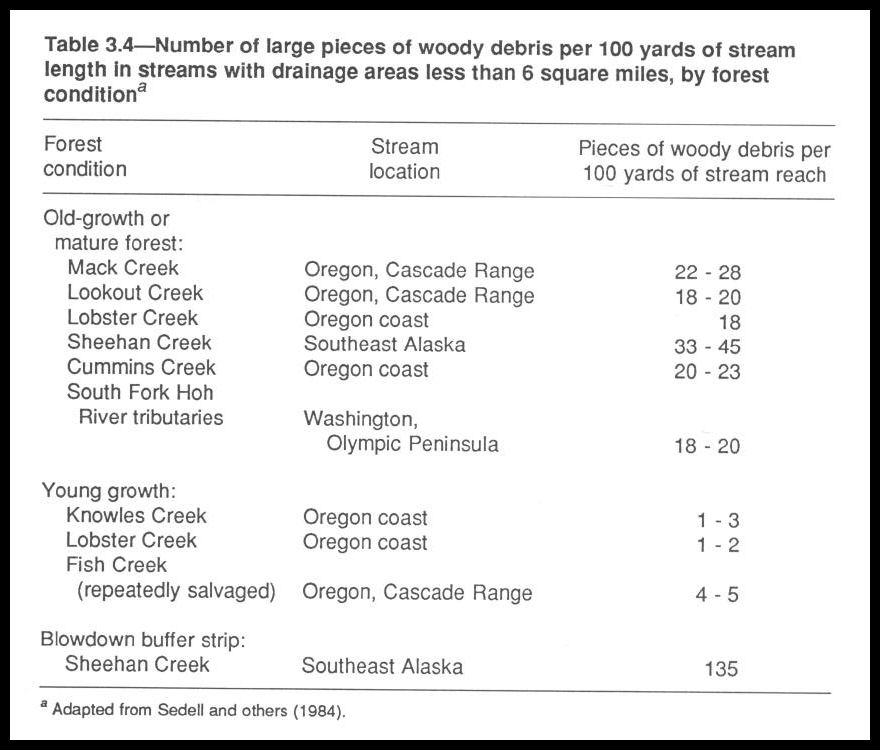
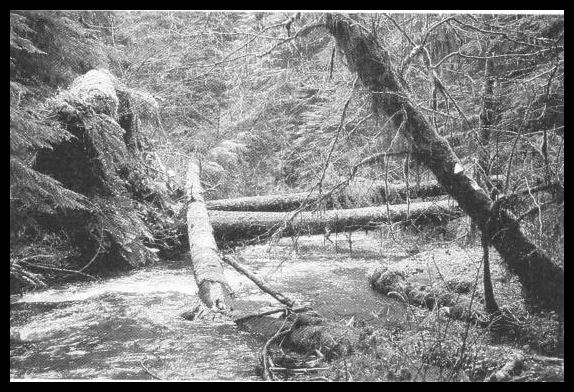
Figure 3.10-The average length of large pieces of downed wood in pristine forested streams, such as those shown, is greater than those in streams in managed forests.
Page 61
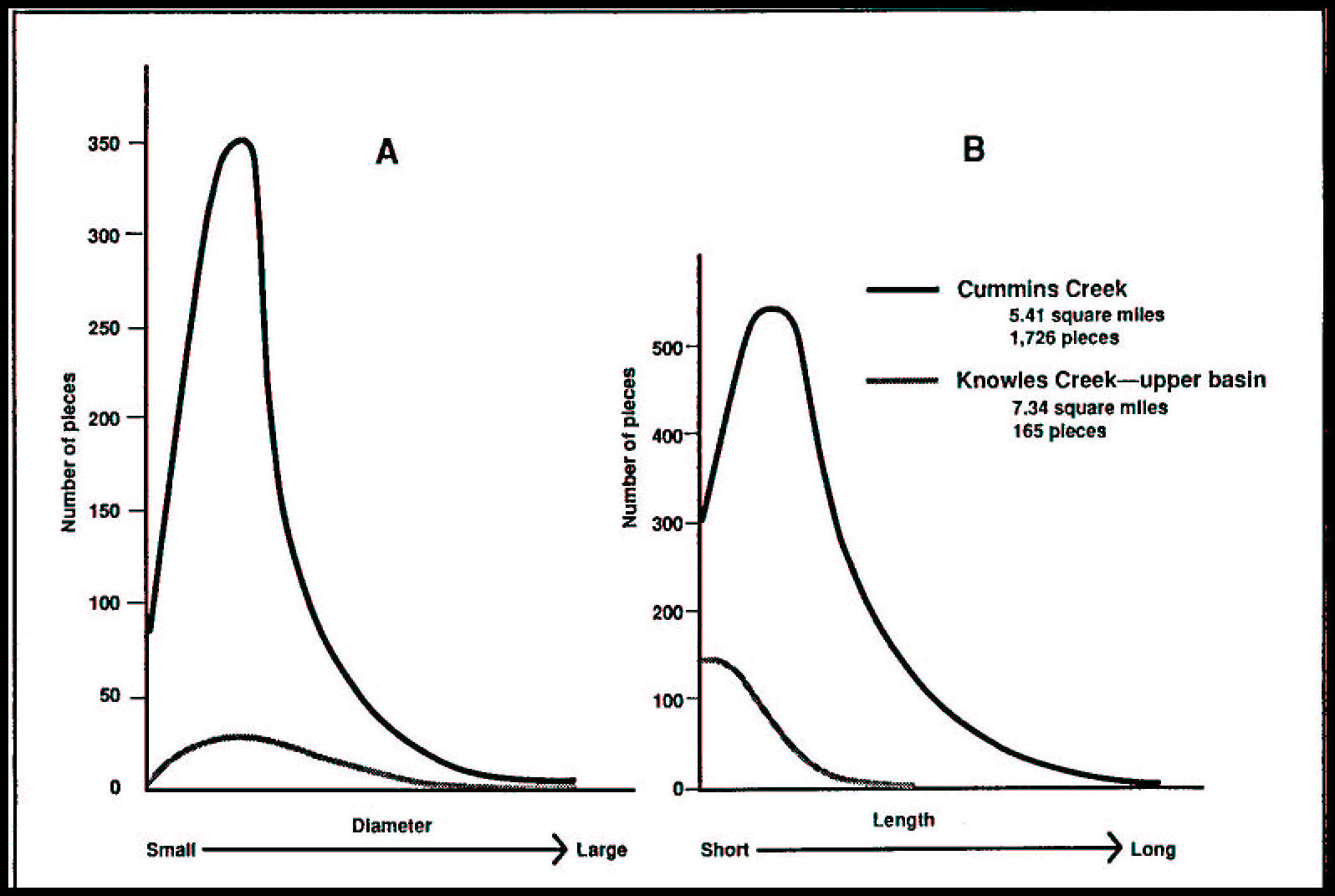
Figure 3.11-Instream frequency trends for an old-growth forested watershed (Cummins Creek) and a second-growth (less than 30 years) watershed (Knowles Creek) in the central Oregon Coast Range: A. Diameter of woody debris. B. Length of woody debris.
The North Fork Breitenbush, a high gradient, sixth-order stream in the central Cascades of Oregon, at bank-full stage is often wider than 98 feet, large enough to move even the largest and longest, downed trees. The river is divided by a wilderness boundary. Salvage logging had been carried out several times since 1965 on the lower 60 percent of the fish-bearing channels of the river. The average length of wood pieces in the managed stream was about 26 feet compared with 48 feet in the wilderness stream (fig. 3.12). Between 49 and 64 percent of the total large pieces of wood were less than 15 feet long in the managed stream compared with less than 18 percent in the wilderness stream. Pieces of wood longer than 50 feet accounted for more than 41 percent of the total wood in the wilderness stream compared with 8 to 17 percent in the managed stream (fig. 3.13). About 67 percent of the pieces of wood with a rootwad attached were longer than 49 feet in the wilderness stream compared with 14 to 23 percent in the logged stream. Stumps made up more than 60 percent of the wood in the managed stream compared with less than 6 percent in the wilderness stream. Total volume of wood had not changed for the wilderness or the managed streams, but the pieces were much less stable in the salvage-logged stream where the channel had widened by 40 percent. Clearly, the trend is toward smaller and fewer pieces of wood in stream channels of all sizes in the logged areas (fig. 3.14; compare with fig. 3.10). In addition, stream channels in the logged area are wider and less stable. The volume of wood may be the same in the managed and the unmanaged streams, but it is more clumped in the managed forest and volume per unit of stream area is less.
Page 62

Figure 3.12-Length of pieces of wood in the North Fork Breitenbush River.

Figure 3.13-Frequency of wood pieces with rootwads, North Fork Breitenbush River.
Page 63

Figure 3.14-The trend is toward smaller and fewer pieces of wood in channels of streams running through managed forests.
Residence Time and Stability of Fallen Trees
Longevity
The residence time of woody debris in stream channels is affected by transport processes, chemical constituents of the wood that affect decomposition rates, and resistance to breaking and abrasion. Dendrochronologic dating of instream debris in coniferous forests of the Pacific Northwest has identified pieces that have been in channels for 200 years or more (Keller and Tally 1979, Swanson and others 1976). Old-growth conifer debris is estimated to decay at a rate of 1 percent per year, although the rate may vary among tree species (Grette 1985). Western redcedar resists decomposition in streams better than does Douglas-fir or western hemlock, but all three conifer species far outlast red alder (Anderson and others 1978).
Logging alters the composition of riparian vegetation by reestablishing early successional stages. Debris from young-growth stands has a shorter residence time in stream channels than debris from preharvest forests. The frequency of red alder debris in young-growth forested streams is about twice that of alder in old-growth streams (Grette 1985). Red alder disappears from streams in young-growth forests more rapidly, however, than does conifer debris (primarily hemlock and spruce) because the alder debris is shorter, of smaller diameter, more easily broken, and less well anchored than conifer debris from the preharvest forest. The rate of input of alder debris from young-growth stands exceeds the input rate of conifer debris, but the reduced longevity of alder debris results in streams with less cover and fewer pools than streams in unlogged forests. Loss of cover in streams in young-growth forests has the most significant impact on salmonid populations in winter, when fish are strongly attracted to debris (Grette 1985) (fig. 3.15).
Page 64
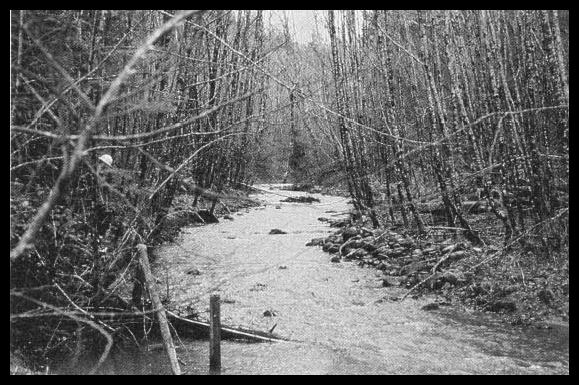
Figure 3.15-Loss of cover in streams in young-growth forests has the most significant impact on salmonid populations in winter.
Stability of Fallen Trees
Stable debris accumulations are assumed to be important for maintaining good fish habitat. If debris does not move frequently, its functions of pool anchoring, cover, and substrate storage are increased over those of unstable accumulations (Bryant 1983). Size, including length and diameter (fig. 3.16), is a major factor contributing to debris stability (Bilby 1984, 1985; Bryant 1983; Grette 1985; Toews and Moore 1982). Other dimensions, such as the presence of a rootwad or branches, also influence when or where a piece of debris will move. Debris length appears to be most important to its stability where stream discharge is sufficient to float large diameter stems (Bilby 1985, Swanson and others 1984). Branches and rootwads add to the stability of debris pieces by increasing the mass and surface area available for snagging on instream obstructions; whole trees are thus potentially more stable than tree fragments. Tree fragments, about half the width of a bank-full channel, were floated downstream during winter storms, but large stems with intact rootwads remained in place for at least 70 years in small, low gradient streams in southeast Alaska (Bilby 1981, Swanson and others 1984). Relatively short pieces of debris can be stable in narrow channels, but longer pieces are necessary for stability in wider channels. Trees whose length exceeds that of a bank-full channel may have much of their weight supported by ground outside the channel where they lodge against standing trees during high streamflow (Swanson and others 1984).
Other aspects of debris that influence stability include orientation, degree of burial, and the proportion of the piece that lies in water. Whether a piece is buried depends in part on the rate of sediment input to the channel and the longevity of the piece. Pieces are stable if their angle of orientation relative to the axis of flow is less than 30 degrees; they are likely to move, however, if their angle of orientation is greater than 60 degrees (Bryant 1983). The degree of burial strongly influences debris movement; pieces with both ends anchored to the streambed or bank move less than pieces with only one or neither end buried. The degree of burial also influences potential movement (Bilby 1984). Partial burial is less effective than complete or nearly complete burial in preventing downstream transport during storms (Grette 1985, Toews and Moore 1982).
Page 65

Figure 3.16-Relation between the length and diameter of stable debris and channel width. Each point represents the geometric mean length or diameter of logs not held in place by other debris at each of the western Washington study streams (adapted from Bilby (1985) and Bisson and others(1987)).
Even the largest fallen trees cannot span the bank-full channel width in large rivers. In such cases, the amount of wood and the number of fallen trees on exposed gravel bars provide constancy to wood in the river channel even though position of the material may change annually. The likelihood of fallen trees being transported back to the main channel is greatly reduced once they have formed jams at bends or outer margins of the flood plain, unless the river changes course.
Page 66
Much relatively small debris enters streams after logging and is therefore more apt to move than would naturally occurring debris (Bryant 1980, Grette 1985, Lammel 1972, Swanson and Lienkaemper 1978, Toews and Moore 1982). Removing all newly added debris after logging, a requirement of many forest practices regulations, may involve bucking large debris into smaller pieces that are removed to the high water line. Such mandatory debris cleaning, however, usually takes place during low flow periods, and some of the material deposited on the upper bank may subsequently re-enter the stream at high flows. This increases the amount of shorter, less stable pieces in the channel (Bisson and Sedell 1984, Hogan 1985, Lestelle 1978, Osborn 1981).
High quality fish habitat declines as debris is exported (Bryant 1985, Scrivenerr and Andersen 1984). Downstream transport of small, unstable debris can lead to accumulations in debris dams that may remain in place for only a few years before moving on. Although debris dams may temporarily block fish migration, a greater longterm consequence for fish populations is the lack of large structure in the channel after debris is removed. Debris loading increases immediately after logging, then declines as accumulations gradually wash away (Bryant 1982, 1985; Toews and Moore 1982).
Processes of Wood Removal
Large floods move great quantities of wood onto the upper flood plain and downstream. Low frequency, high magnitude floods add much material to streams. The wood becomes more clumped through either flood or debris torrent forces. On small coastal streams, debris torrents may temporarily dam sections of streams draining basins larger than 6-9 square miles. When these dams fail, the resulting debris flood scours wood from the channel and deposits it high on banks or in estuaries.
Physical abrasion is the most powerful mechanism for removing stable pieces of wood from streams and rivers. Sand and gravel carried at flood velocities abrade large pieces of wood. Abrasion is greater in high gradient or sediment-rich streams than in gentle, spring-fed or low-gradient streams and rivers.
Biological decomposition is only a minor process in removing wood from streams. Water-logged wood decays slowly, but wood at the stream-terrestrial interface hosts very active microbial and invertebrate activity. Here, the biotic components respond to a gradient of temperature, moisture, and oxygen. Wetting and drying at the stream terrestrial interface allows rapid biological decomposition of wood (Triska andCromack 1980).
Forest management has greatly influenced the sequence of events in watersheds. The impact of natural processes that increase the rate at which woody debris disappears from stream systems is minimal compared with the impact of human activity on disappearance of wood over the last few decades.
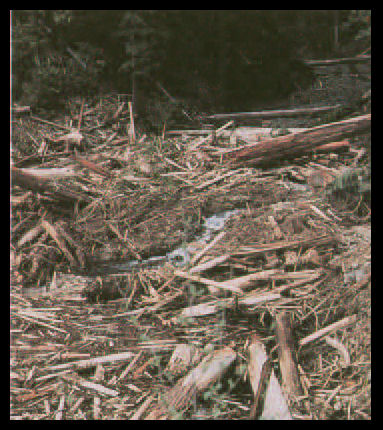
Figure 3.17-A terminus of a debris torrent that would have been a candidate for stream cleanup in the 1960's and 1970's because of the slash.
Streams may be cleaned either immediately after logging to remove slash, or later to remove a specific blockage of fish passage (fig. 3.17, color). Postlogging stream cleaning is usually done by a professional crew with small equipment. Debris barriers to fish are usually removed under the supervision of a fishery biologist, who may need to use heavy equipment and explosives. Stream cleaning may damage fish habitat (Sedell and others 1985).
Page 67
The State of Washington has required thorough removal of logging slash from streams for about the last 10 years. During this time, the effect of stream cleaning has been evaluated in several Pacific Northwest areas. In almost every such study, debris removal has resulted in loss of important habitat features and reduced fish populations (Bryant 1980, Dolloff 1983, Elliott and Hubartt 1978, House and Boehne 1985, Lestelle 1978, Lestelle and Cederholm 1984, Osborn 1981, Toews and Moore 1982).
Removing large, stable wood along with smaller material reduces channel stability and the quality of pools and cover. Small, easily floated wood has sometimes become temporarily abundant after stream cleaning (Meehan and others 1969, Toews and Moore 1982). Any such increases have come from new slash entering the water from debris stacked near the high water line during cleaning, or the breakup of wood in the stream before logging. In most cases, unstable debris is flushed from the cleaned reach within a few years, and channels are thus degraded.
The proportion of riffles increases and the number of pools decreases in cleaned stream channels (Bisson and Sedell 1984). The increased frequency of riffles increases the abundance of underyearling steelhead and cutthroat trout, which prefer riffle habitats; however, the abundance of coho salmon and older age classes of steelhead and cutthroat, which prefer pools, is correspondingly reduced.
State and Federal agencies annually spend more than $6 million to remove debris jams, but the impact on habitat has had little study. In one study, fish populations in the vicinity of log jams were reduced immediately after complete removal of debris, but abundance did not decline significantly where part of the jam was allowed to remain (Baker 1979). Downstream spawning and rearing areas were damaged by large flows of sediment released when the log jams were removed. Partial removal appears to be biologically preferable to complete removal and is less expensive.
Most salvage logging in streams has been done since the great Pacific Northwest storm of 1964. Since then, Federal funds have been provided for cleaning and salvaging wood from streams after every major storm. Major timber sales on public land focus on streams of fifth-order or larger because access to established main roads is easy. A major reason for removing woody material from streams has been protection of downstream bridges and culverts to reduce property liability court cases. Even some sports clubs remove tree debris from rivers where such obstacles might impede travel (Oregonian 1986).
Use of wood-burning stoves has increased tremendously in the last 10 years (fig. 3.18). Most of the wood cut for fuel does not come from streams, but the demand for high quality wood that might otherwise reach a stream is great.
In the last 100 years, millions of trees have been cleared from rivers. County sheriffs, port commissions, and recreational boaters routinely clear fallen trees from rivers for safety and convenience. As a result, most Pacific Northwest rivers bear little resemblance to their pristine condition.
Page 68

Figure 3.18-Forest Service, Pacific Northwest Region, free
use wood permits.
Trends in Wood Inputs
Riparian zones in the past have supplied large trees to the stream, but most stream-banks now have smaller trees of fewer species. Most big cedars and Douglas-firs along streams in the Cascades and along most coastal streams greater than third-order have been removed or are about to be. On private land, 60-70 percent of conifer trees larger than 14 inches in d.b.h. have been harvested within 100 feet of a fish-bearing stream (table 3.5) in both the Oregon Coast Range and the Cascade Range. Fewer conifers than might be expected, larger than 12 inches in d.b.h., are growing along coastal streams (Sedell, unpublished data).
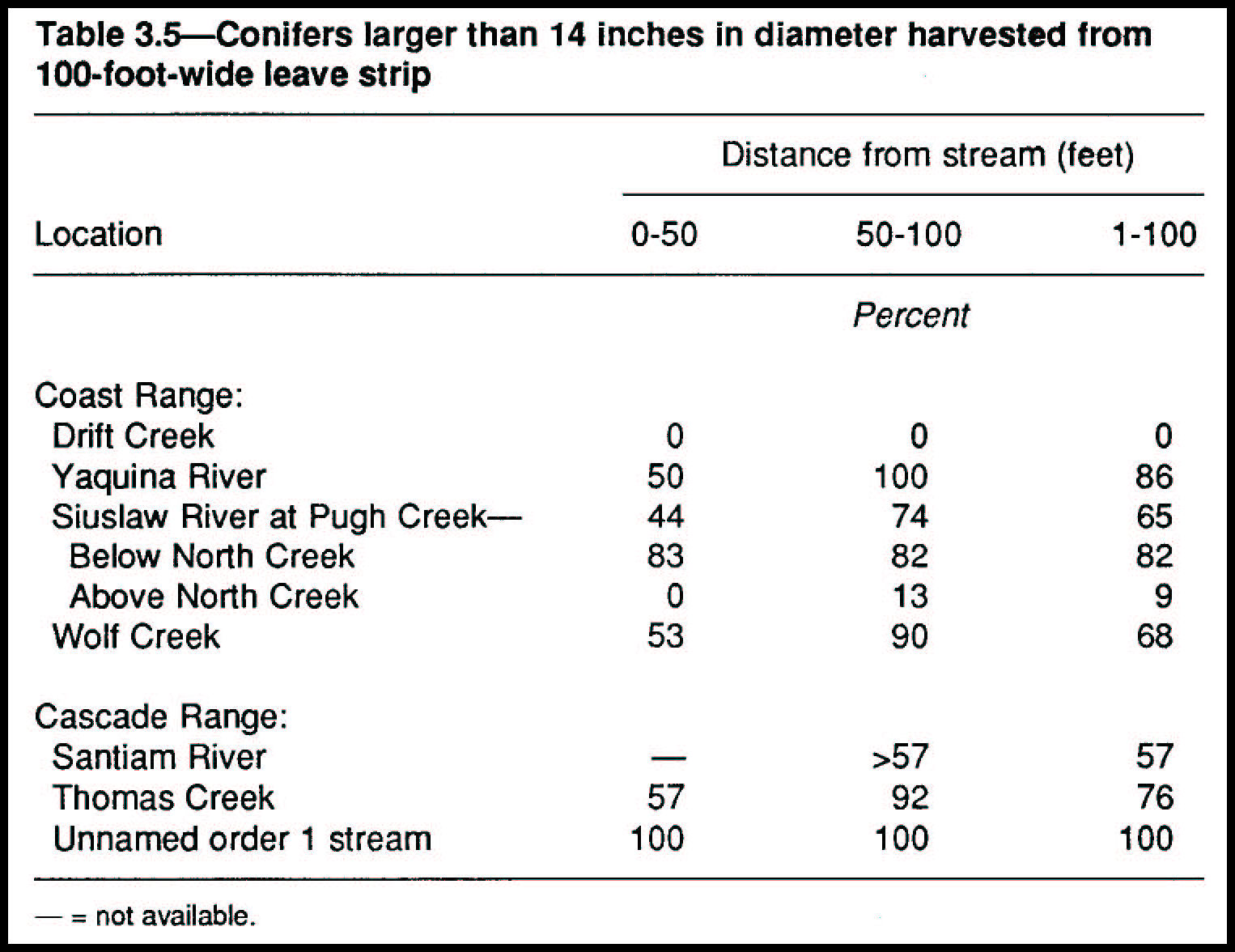
Page 69
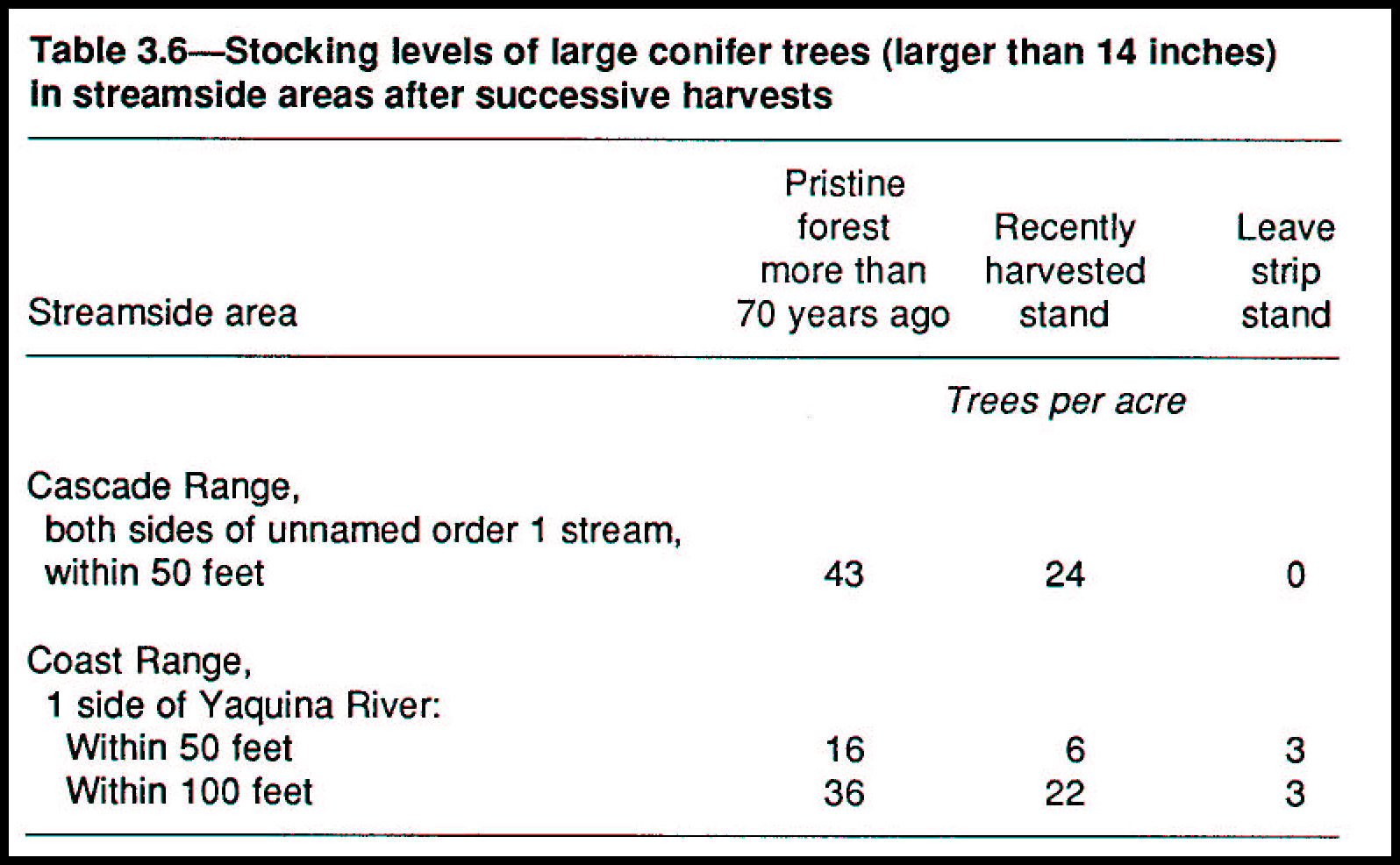
The number of streamside conifers larger than 14 inches in d.b.h. has been drastically reduced from the number present 70 years ago at the first harvest (table 3.6). Conifers larger than 14 inches in d.b.h. ranged from only 0 to 19 percent of the pristine stocking level after recent logging.
Wood as Habitat in Freshwater Systems
Influences of Wood on Stream Characteristics
Woody debris influences stream channel flow and creates and maintains rearing habitat for salmonid fishes (Lisle 1982, Sullivan and others 1987). Free-swimming species, such as salmon and trout, require rearing sites where food is plentiful and little effort is needed to hold a feeding position against the current (Dill and others 1981, Fausch 1984). Such small, quiet areas are usually located behind boulders and are occupied by large, aggressive fish (Bachman 1984). Stream riffles have few such sites.
Some species, notably coho salmon, avoid riffle habitats almost entirely when competitors are present (Bisson and others 1982, Dolloff 1983, Hartman 1965); instead, they rely on pools with ample cover provided by large woody debris (Bisson and others 1985, Stein and others 1972).
Most stream fishes inhabit pools in which the current velocity is lower and the water usually deeper than in riffles. Deep pools offer fish a better chance of escaping from terrestrial predators, and also allow fish of different species or age classes to coexist in layers within the water column (Allee 1982, Fraser 1969).
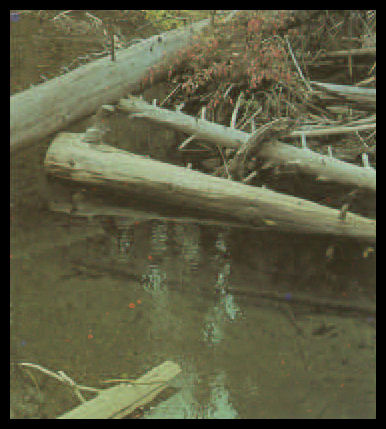
Figure 3.17-Woody debris creates many of the pools in Pacific Northwest streams.
Woody debris creates many of the pools in Pacific Northwest streams (Keller and Swanson 1979, Swanson and others 1976) (fig. 3.19, color). In small streams (up to about 3d order), single large pieces of debris or accumulations of smaller pieces anchored by a large piece often create a stepped longitudinal profile (fig. 3.20;fig. 3.27, color) that consists of an upstream sediment deposit, the debris structure,
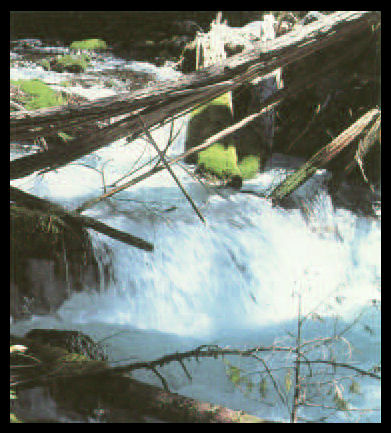
Figure 3.21-Accumulattons of small debris behind one large piece of debris often create a longitudinal, stepped profile.
Page 70

Figure 3.20-Role of woody debris in storing sediment and creating pools in streams: The "stepped profile" is characteristic of stored sediments and plunge pools created by woody debris. Removing a debris dam destroys and reduces these habitat features (adapted from Bisson and others 1987).
and a downstream plunge pool (Heede 1972, 1985). Numerous debris accumulations generally increase pool frequency (Lisle and Kelsey 1982). Numbers of pools are positively correlated with numbers of debris pieces in low-gradient streams (Grette 1985). Eighty percent of the pools in small streams of the panhandle of Idaho are caused by fallen trees larger than 10 inches in diameter (Rainville and others 1985). The frequency and volume of pools decrease in stream channels from which slash and naturally occurring debris were removed after logging (Bilby 1984, Bisson and Sedell 1984, Toews and Moore 1982).
The position of debris also influences the size and location of pools. The size of a single stem or the accumulation of stems spanning the channel affects the size of the associated pool. In an experimental flume, larger logs created longer and deeper pools, provided they were suspended above the streambed (Beschta 1983). In other studies, pool area was positively correlated with the volume of debris that anchored the pool, and the correlation improved as channel width increased in streams up to 7 feet wide (Bilby 1985, Bisson and others 1987) (fig. 3.22). Many pools, however, are created by eddies behind debris and other structures located at the channel margin rather than by the scouring action of channel flow. These backwater or eddy pools, common in all streams, are used by salmonids throughout the year for rearing (Bisson and others 1982; Bryant 1985; Bustard and Narver 1975a, 1975b; Dolloff 1983; Gibson 1981; Lister and Genoe 1979; Mundie 1969; Murphy and others 1984; Sedell and others 1982a, 1984; Stein and others 1972; Tschaplinski and Hanman 1983).
Page 71

Figure 3.22-Relation between size of woody debris and pool area created for different-size streams in the Pacific Northwest. One 12-inch Douglas-fir tree contains about 72 cubic feet of wood; adapted from Bilby (1985).
Woody debris increases the complexity of stream habitats by physically obstructing waterflow. Trees extending partially across the channel deflect the current laterally, causing it to widen the streambed (Zimmerman and others 1967). Sediment stored by debris also adds to hydraulic complexity, especially in organically rich channels that are often wide and shallow and possess a high diversity of riffles and pools in low gradient streams of alluvial valley floors (Keller and Swanson 1979, Keller and Tally 1979). Even if the stream becomes so large that trees cannot span the main channel, debris accumulations along the banks cause meander cutoffs and create well-developed secondary channel systems (Keller and Swanson 1979, Swanson and Lienkaemper 1982). Debris also creates variation in channel depth by producing scour pools downstream from obstructions (Hogan 1985, Keller and Tally 1979). Wood therefore maintains a diverse physical habitat by (1) anchoring the position of pools along the direction of the stream, (2) creating backwaters along the stream margin, (3) causing lateral migration of the channel and forming secondary channel systems in alluvial valley floors, and (4) increasing depth variability.
Large, fallen trees affect live vegetation along watercourses. Trees carried by floodwaters can severely batter live plants on a flood plain, but normally only in a narrow belt along the immediate channel. Large, stabilized pieces of wood, on the other hand, protect riparian sites where alder and other species of plants can become established.
Page 72

Figure 3.23-Note the large pieces of wood on the flood plain, especially in the lower right corner where stable wood has formed a protected site that has allowed the alder to grow.
Live vegetation eventually stabilizes a stream channel. Features, such as gravel bars, also become stabilized and enriched with fine sediments and organic materials as plant root systems develop and the stems resist the flow of water and reduce its velocity.
Fallen trees protect thickets of vegetation on exposed channel bars. Alders growing in channel bar areas not protected by down trees are repeatedly pruned heavily by floating woody debris and moving bedloads (Swanson and Lienkaemper 1982) (fig. 3.23). The down trees that protect the outer edge of a thicket and those in the thicket itself create local environments of quiet water where fine sediments and organic debris are deposited during high flows. This debris, coupled with leaf and woody litter from the stand, boosts soil development and vegetative growth. The large, fallen trees thus help a stand to reach a stage of structural development that allows it to better withstand floods. Fallen trees on gravel bars also provide sites where some stream-transported species of hardwoods and shrubs can reroot and grow.
Stream restabilization after major floods, debris torrents, or massive landslides is accelerated by large, woody debris along and within the channel. After wildfire, while the postfire forest is developing, an aquatic habitat may be maintained by large, woody debris supplied to the stream by the prefire forests (Swanson and Lienkaemper 1978). In many instances, however, streamside salvage logging destabilizes channel structure and, thereby, the quality of the habitat.
Page 73
Sites of high biological activity and maximum habitat diversity are preferred spawning and rearing areas for salmonids. In the Pacific Northwest, many such zones of sediment and debris are located where a first-order channel debris torrent has entered athird- to fifth-order stream.
Wood as Habitat
Animal associations on woody debris in aquatic systems vary from those restricted to living on the wood to those using it only opportunistically. The sequence of colonists parallels the stage of wood decay. New wood entering a stream is used primarily as habitat, colonized by a community of algae and microbes that in turn provides food for a group of insects called grazers or collectors. This type of feeding does not significantly affect the structure of the wood, but colonization of the superficial layer by fungi softens wood enough that it may be abraded and ingested by invertebrates that scrape their food off surfaces. Most important, however, the wood becomes suitable for obligate wood grazers and the more generalized wood shredders, such as caddis-flies and stoneflies, which eat fungal-infested wood. These activities result in a sculptured surface texture that provides habitat for many organisms. Decades of fungal colonization and growth soften the wood and allow oxygen to penetrate. Invertebrates that bore into the internal matrix of a fallen tree speed the decomposition process by consuming the wood and by transporting microbes into the tree. In the final phase of decay, detritivores, such as earthworms, penetrate the material; continued decomposition then resembles organic matter in soil and damp, terrestrial habitats (Anderson and others 1978, 1984; Dudley and Anderson 1982) (fig. 3.24).
Some wood that enters a small stream is already altered by fungi and other terrestrial organisms. Such preconditioning allows more rapid internal colonization by aquatic microbes and invertebrates and thereby shortens the aquatic decomposition process. Decomposition is also faster in large streams during periods of high water because physical abrasion removes softened tissue as the wood is transported or deposited in the stream. Rotting wood cannot retain enough structural integrity to provide a substrate for aquatic invertebrates during the final stages of decomposition except in small headwater streams or in backwaters of large streams.
Page 74
Wood quality and texture help determine the kinds of organisms that will colonize a piece of wood. The species of wood, degree to which it is waterlogged, and decay class all affect the quality. The extent of colonization by terrestrial fungi and woodboring insects also influences the attractiveness of the wood once it enters the water because such activity is closely associated with decay class.
The ecological role of wood-eating aquatic invertebrates is limited compared with that of terrestrial systems and marine environments. The three most important wood processing invertebrates in Oregon streams consume about 2 percent of the available woody debris per year in small streams (Anderson and others 1978, Steedman and Anderson 1985). Wood processors are more abundant on hardwoods than on conifer wood. Microbial activity and nitrogen content are greater in decaying alder than in decaying conifer wood, a nutritional difference that helps explain the higher abundance of processors in hardwoods.
Summer populations of salmonids in western Washington streams flowing through old-growth forests have been compared with those in recently clearcut areas (Bisson and Sedell 1984). Total salmonid biomass increased after logging, but species richness declined to a population of only steelhead trout, most less than 1 year old. Coho salmon and cutthroat trout, between 1 and 3 years old, were proportionately less abundant in logged areas (Bisson and Sedell 1984). The shifts in species composition and age groups are related to habitat changes after logging of old growth and removal of large, stable, woody debris from the stream channel. Stable debris declined and unstable debris increased in the years after the 1976 Washington Forest Practices Act that mandated immediate removal of debris after logging (fig. 3.25). Pool size decreased and riffle size increased after old growth was clearcut and the stream channel cleared. Numbers of pools and riffles per unit of stream length declined after logging, which suggests that normal stairstep stream profiles had been reduced to a more even gradient (fig. 3.26).
Coho biomass in coastal Oregon streams is directly related to pool volume. Large, stable, woody debris is preferred as protective cover by young coho salmon, yearling steelhead, and older cutthroat trout, particularly in high-gradient river systems (Bisson and others 1987; Bustard and Narver 1975a, 1975b; Everest and Meehan 1981; Lister and Genoe 1979; Nickelson and others 1979; Osborn 1981; Sedell and others 1982a, 1982b, 1985).
Most salmonid species use different habitat in winter than in summer. Large, stable, woody debris is important winter habitat for coho salmon, steelhead trout, and cutthroat trout because it enhances the use of other habitats within pools. All species prefer pools during base streamflows in winter, but the level of preference is determined by pool quality and abundance of woody debris; the more woody debris, the more fish use the pool. Large, stable debris also attracts fish to pools along the stream edge rather than to those in midchannel.
During winter floods, the pool-riffle sequence or stairstep stream profile becomes a continuous, high-velocity torrent, in which there is little protection for salmonids from moving bedload sediment or swift, turbulent waters. During these brief flood periods, slack water refuges are associated almost exclusively with debris as fallen trees and standing vegetation in riparian flood plains. All three species of salmonids enter these
Page 75
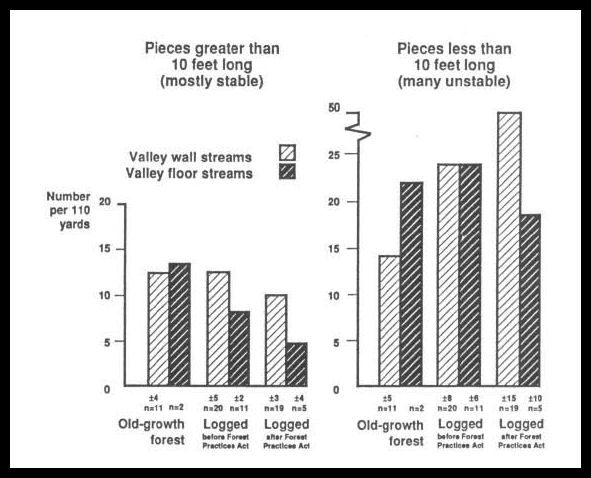
Figure 3.25-Effects of stream cleaning on the relative abundance of stable and unstable debris in steep valley wall streams and low-gradient valley floor streams in southwestern Washington; after implementation of the Washington Forest Practices Act; adapted from Bisson and Sedell (1984). Number of sample sizes is indicated on each bar.

Figure 3.26-Comparison of volumes and frequencies of pools and riffles in streams in old-growth forests with streams in recently clearcut areas; 95percent confidence limits and sample sizes are indicated on each bar.
debris-enhanced refuges until streamflows subside. Large, woody debris may also expand the feeding space by creating or enhancing areas of slow-moving or standing water in organic-rich flood plains, even along the smallest streams (Bustard and Narver 1975a, 1975b; Koski and others 1985; Murphy and others 1984).
Page 76
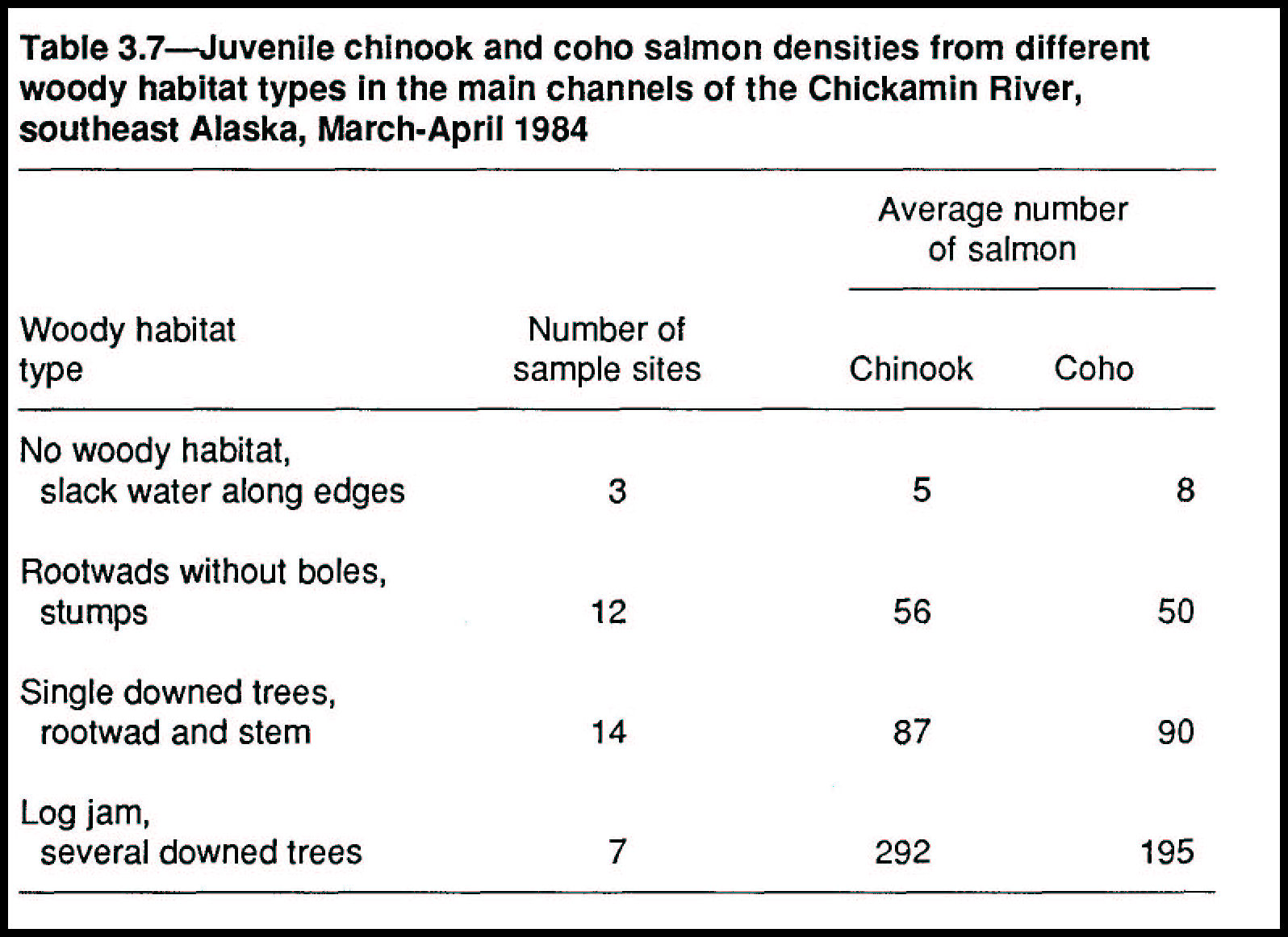

Figure 3.27-Densities of coho salmon in Upper Queets River side-channels, which are capped or plugged at the head by cobble and organic debris. Plugged side-channel areas represent 58 percent of total side-channel habitat; unplugged side-channels, 31 percent; and intermediate side-channels, 11 percent. Bars represent 95percent confidence intervals.
Almost all juvenile anadromous fish in large rivers are reared on stream edges in a wood-rich environment (table 3.7 and fig. 3.27). Whole fallen trees or debris jams offer more productive, more diverse habitat than that around rootwad or stump habitats (Canadian Fisheries and Marine Service and The International Pacific Salmon Fisheries Commission 1979; Cornelius and Siedelman 1984; Sedell and others
Page 77
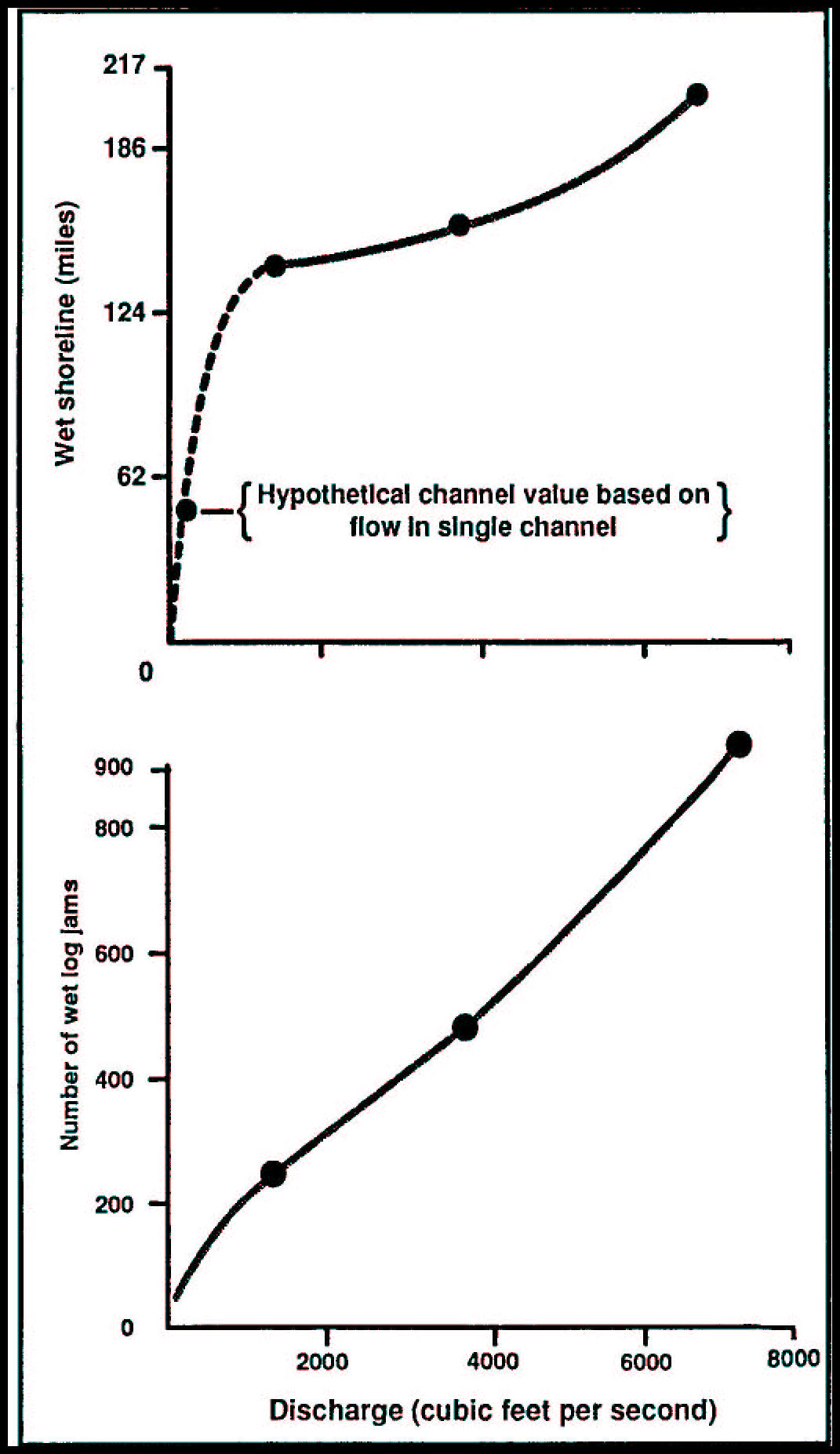
Figure 3.28-Relation between discharge and selected rearing indices in the Morice River.
1982a, 1984). Essentially, the hydraulic forces around any rough element such as fallen trees or stumps mainly determine the quality of fish habitat. Relations between discharge and wet debris jams can be quickly constructed to determine changes in fish habitat quality caused by salvage operations or water diversions (fig. 3.28).
Page 78
Decomposition and Nutrient Cycling
Trees falling in streams decompose at different rates and in different patterns than those that fall to the ground. Wood decomposes more slowly in water than on land; waterlogging prevents deep penetration of oxygen into the wood. The fungi and invertebrates that cause the most rapid decomposition of fallen trees on land are also strongly aerobic (Triska and Cromack 1980). Waterlogged parts of fallen trees decompose in thin (0.25 inch) surface layers. As the decomposed surface is grazed or abraded, oxygen penetrates farther into the wood, and that area becomes food for the decomposers. If only part of a fallen tree is constantly in contact with water, that part decomposes slowly, but the exposed part may decompose rapidly because neither low oxygen nor extremes of moisture limit decomposer activity. Trees that fall in very small streams may contact water only during the rainy season when streamflow is highest. Low stream level and air drying the rest of the year may speed wood decomposition.
The concentration of essential nutrient elements increases as large pieces of wood decompose. Nitrogen increases primarily through biotic use of the carbon and through nitrogen-fixing micro-organisms. Nitrogen fixation on fallen trees in streams accounts for 5 to10 percent of the annual nitrogen supply to the stream (Triska and others 1982). Although bark decays more slowly than wood, the tannins in Douglas fir bark do not affect nitrogen fixation (Baker and others 1983).
Although rates of biotic wood processing differ in stream systems from headwaters to mouth (terrestrial to marine) (table 3.8), the slow decomposition of wood in freshwater streams maximizes the influence of wood on stream stability and as habitat. As we understand better the critical function of large organic material in streams and rivers, we realize that productivity of aquatic habitats depends on the biological diversity provided by a continuous supply of coarse woody debris.
Page 79
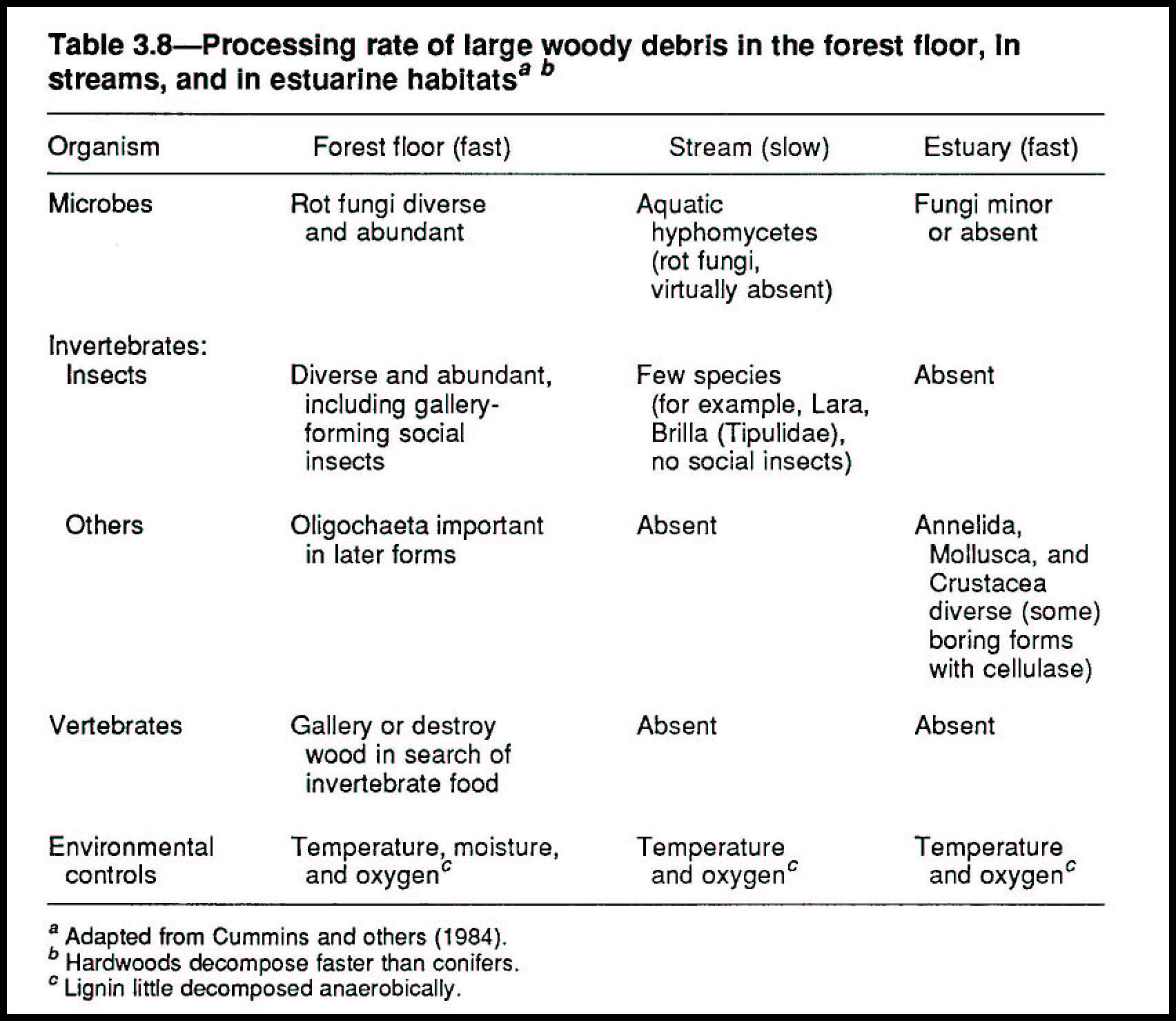
Page 80
Had the color figures on this page. They have been placed throughout the document.
Page 81
This page was intentionally left blank
Page 82